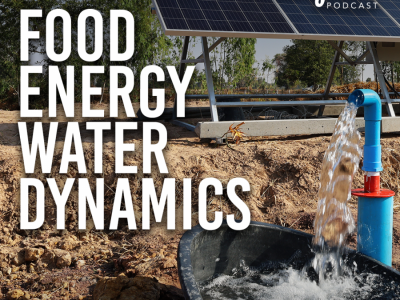Kachchh: An Oasis
A belt of land, 160 miles from east to west and from thirty-five to seventy from north to south, Kachchh (pronounced as Cutch) is almost cut off from the continent of India, on the north and east by the Arabian sea and the eastern or Kori mouth of the river Indus. From its isolated position, the special character of its people, their peculiar dialect, and their strong feeling of personal loyalty to their ruler, the peninsula of Kachchh has more elements of distinct nationality than any other dependencies of the Bombay Government.
The earliest natural resource accounts by erstwhile British rule in 1880 precisely put peculiarity of one of India’s least populated yet culturally vibrant regions, Kachchh. Located in the westernmost part of India, Kachchh is an arid region with sporadic rainfall and no perineal or reliable surface water resources. As shown in Figure 1, Kachchh is surrounded by Rann (salt beds or non-arable land) and Sea. For a long time, the region was isolated from mainland India and the rest of the world due to inhospitable surroundings that made the mainland area (Figure 1) inaccessible. However, the mainland area is an oasis with flourishing agriculture and vibrant livelihood. Kachchh is a manifestation of a post-disaster high agrarian and economic growth fueled by the invisible water resource, groundwater. Concomitantly, it shows how the negligence of sustainable groundwater management poses a threat to the socio-economic stability of a booming economy.

Groundwater: Providing Water for Socio-Economic Development
Due to limited water and financial resources, Kachchh did not experience economic development until 2001. On Jan 26, 2001, the region was shaken by a colossus earthquake measuring 7.7 on the Richter scale. The region was shattered completely, with more than 20,000 lives lost. Of 1,055 villages, 178 were destroyed, while 165 villages had more than 70% of their property destroyed in the earthquake. The major towns of Bhuj, Rapar, Anjar, and Bhachau lost more than 70% of their infrastructure too..
The disaster became an opportunity for the region as it saw an influx of aid and redevelopment money. An estimated $1.77 billion for reconstruction and rehabilitation work was developed by the World Bank ($687.5 million), Asia Development Bank (ADB) ($350 million), and other state and central governments. The region also attracted private investment and philanthropic support from communities attached to the region. As a result, the region experienced the development of its economy with new investments across production industries, tourism, and agriculture. Much of the wealth generated in the secondary and tertiary sectors was reinvested in the agriculture sector. As a result, a new groundwater irrigation boom was observed in primarily rainfed agriculture (Figure 2).
As shown in Figure 3 and Table 1, the agriculture yield and production value have increased significantly since 2001. However, the growth in groundwater abstraction through deeper tube wells led to rapid groundwater depletion. Due to groundwater depletion and seawater intrusion, the groundwater salinity has been increasing. (Figure 4) Groundwater, a crucial source in agricultural development, is becoming a challenge in sustaining agriculture due to its increased depth and salinity. This challenge appropriates the local saying, જે પોસતુ તે મારતુ, આવો દીસે ક્રમ કુદરતી (who feeds you is also one who beats you.)



Sustaining Groundwater for Sustaining Development
The ever-increasing water demand in Kachchh is further stressed with climate change impacting rainfall. Historically Kachchh experienced 10– 15 rainy days in a year. The further shrinking of the rainy season in recent years has increased surface runoff and lessened groundwater recharge. It needs intervention from three fronts to tackle the current rapid depletion.
Institutionalizing Groundwater
In the case of groundwater and overall water demand, a community-based regulatory framework for judicious water usageis essential for sustainable groundwater management. Efforts are already put up by a few non-governmental organizations (NGOs) to assemble individual farmers to collectively manage their borewells and Water Extraction Mechanisms (e.g., electric pumps, diesel pumps). Provisions shall be imposed to penalize the inefficient and prodigal users. Furthermore, budgeting for water shall be done collectively for agricultural, domestic needs and natural usage by flora and fauna.
Preventive Measures (Managing Supply)
Rainwater harvesting is the most feasible way of ensuring the supply of water. Natural recharge is difficult due to scanty and erratic rainfall, but Kachchh is suitable to adopt artificial recharge and rainwater harvesting. The freshwater stored through water harvesting can be conjunctively used with non-potable brackish water to augment the water supply for irrigation purposes. In Bidada and Kotada (Jadodar) villages, good rainfall in the year 2020 monsoon has provided inter-annual groundwater storage by diverting the surface runoff to groundwater recharge through the defunct borewell. The community is taking up the cause through collective fundraising. If they can be provided institutional or financial support from the government, the region can come up with an exemplar story of reviving from the stage of perils.
Adaptive Measures (Managing Demand)
More than 90 percent of groundwater extracted is used for agriculture. Therefore, there is a need to stimulate low water-consuming irrigation practices. Furthermore, as agriculture is mainly for commercial purposes and not limited to subsistence levels, there is a need to develop local markets and demand for the low water-consuming crops. These measures shall encourage farmers to switch from high water-consuming crops such as alfalfa, traditional cereals, and pulses to low water-consuming horticulture crops such as dragon fruit, dates, etc. In addition, the domestic and industrial water consumption shall be augmented with wastewater recycling and more efficient use in the industrial sector.
References:
Patel, P. M., and D. Saha.(2022) "Groundwater: A juggernaut of socio-economic development and stability in the arid region of Kachchh." In Groundwater for Sustainable Livelihoods and Equitable Growth, pp. 231–252. CRC Press. https://doi.org/10.1201/9781003024101-13
This study, to understand importance of groundwater in Kachchh, was sponsored and facilitated by IWMI-Tata Water Policy Program. Dr Dipankar Saha, Prof Tushaar Shah, and Shilp Verma helped with the case study.
This article was originally on Medium (https://medium.com/@psuwaterstudentgroup/the-treasure-beneath-the-surface-the-role-of-groundwater-in-the-development-of-the-kachchh-region-1d4222605b12) and was republished with permission.





